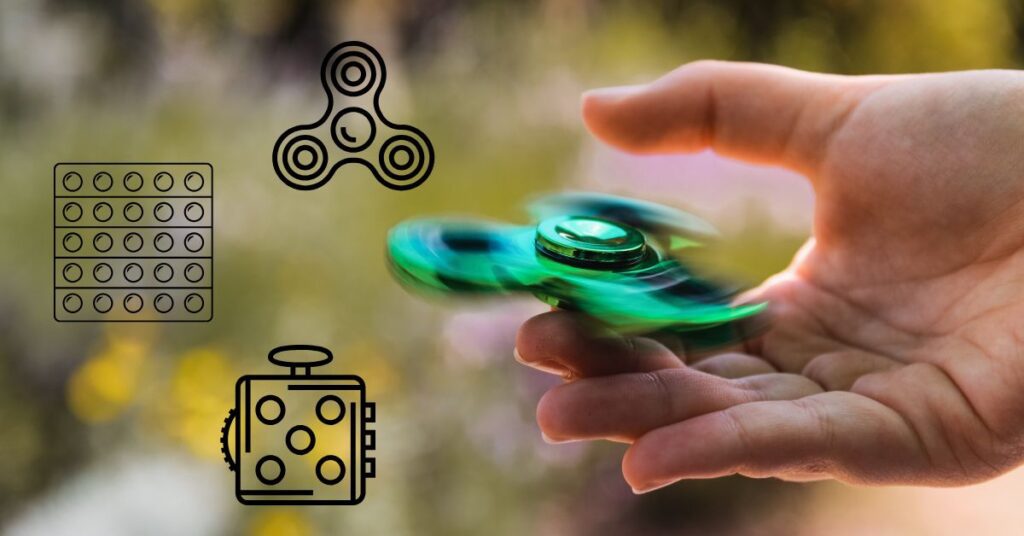Table of Contents
ToggleIs This Stimming?
Ever heard of stimming? You tap a pen during a meeting; the repetitive movement helps you to tune out distractions and focus on what’s being said. You squeeze a stress ball in your hand during a heated conversation; the pressure calms your nerves and helps to keep your emotions from spiraling out of control.
You find yourself swaying back and forth in the checkout line; the motion feels soothing and is a release for excess energy produced by the sensory experience of being in a crowded grocery store. You hum to yourself while doing the dishes; the extra sensory input and “something to do” keeps you present and relieves boredom while completing a less desirable task.
These are all common examples of stimming. Stimming is short for Self-Stimulatory Behavior. Everybody stims! Stimming is part of the human experience. We can all relate to it, because we’ve all done it from time to time.
This article will explore what stimming really is, why it matters, and how to embrace it without shame.

What Is Stimming?
Stimming is a way people can regulate their nervous systems through repetitive movements, mannerisms, vocalizations, and sensory input. It can help with things like increasing focus and attention, managing or expressing overwhelming emotions, and self-soothing during times of stress or anxiety.
Stimming is a common and natural behavior in everyone. But if you are autistic or ADHD, you likely stim more often and more intensely than the average person.
This is because these conditions affect parts and processes of the nervous system that control regulation. Regulation of things like sensory input, emotions, impulsivity, energy, attention, and motivation, to name a few.
Common Types of Stimming:
- Physical: hand-flapping, rocking, jumping, fidgeting
- Oral: humming, singing, chewing
- Visual: watching spinning objects or blinking lights, pattern seeking
- Auditory: repeating sounds or phrases (echolalia), singing
- Tactile: rubbing, tapping, touching textures, playing with your hair
Why We Stim
Sensory Regulation
Stimming can help balance under- or over-stimulation. It can add more sensory input when a person feels under-stimulated. It can also act as a singular stimulus to focus on in an attempt to drown out other input if a person is over-stimulated.
Emotional Regulation
Stimming can be soothing during times of stress, anxiety, or overwhelm. One example is to use repetitive motion. I have a soft rocking chair in my room, and a porch swing in my backyard that help me to feel grounded and regulated. Repetitive motion can be calming to adults, just like young children are calmed by rocking, swinging, or bouncing.
Other calming stims could be things like humming to yourself, watching moving lights, or repeatedly stroking a soft blanket.
Focus and Attention
Stimming can keep the brain alert and engaged (especially in ADHD). Tasks that require long periods of sustained attention or tasks that feel under-stimulating or boring can feel more manageable if you allow your brain and body extra sensory input or output (a release of excess energy)..

Expression of Joy or Excitement
Stimming can also be a natural way to release energy or emotion. Many people like to express excitement or happiness by jumping up and down, waving their hands, or clapping repeatedly. .
Preventing Meltdowns or Shutdowns
Autistic and ADHD people might naturally stim when they are starting to feel overwhelmed. This can act as an early warning system for sensory overload. It might be a signal to the person to lessen their sensory input by leaving the current environment or using sensory accommodations.
Noticing your stimming could help you know when to take action to prevent further nervous system overwhelm that leads to meltdowns or shutdowns. The act of stimming itself can also release excess energy or calm and regulate a person, preventing meltdowns and shutdowns.
Stimming in Late-Diagnosed Adults: Reclaiming What Was Repressed
Stimming is often misunderstood or suppressed, especially by those diagnosed with autism or ADHD later in life.
Masking and Internalized Shame
Many adults were taught that stimming was “weird,” “rude,” or “inappropriate” when they were children. This often leads to people hiding their stims, trying to manage with smaller more subtle stims, or tensing up their muscles to suppress their stims.
As a late-diagnosed autistic ADHDer, I can relate to this. During my school years, I often found myself “white knuckling” my way through. My jaw was clenched, my neck and shoulder muscles were tight, my toes were scrunched up inside my shoes. My body was constantly holding on to extra stress and tension that became repressed and difficult to release..
The Cost of Suppression
Suppressing the need to stim can cause increased anxiety, exhaustion, and disconnection from self.
During my early teen years I remember making my way through my school days feeling like an exhausted shell of a person with a floating balloon for a head that was entirely disconnected from my body.
This eventually led to what I now know was a massive autistic burnout (one of a handful I’ve experienced over my lifetime). I went to counseling and was put on antidepressants, but one day I just couldn’t do it any more.
I was out of school for months while my nervous system took the time it needed to attempt to reboot itself. When I finally went back, I was still in survival mode but there was nothing I could do but push through. And I wasn’t even aware of my sensory needs and had no idea what stimming even was.
This amount of suppression and nervous system trauma over a lifetime of not knowing I was neurodivergent is one of many factors that I believe contributed to my current chronic pain condition.

Recognition and Reconnection
Many late-diagnosed people are learning to identify their lifelong stims and embrace them.
Discovering that I was autistic was a highly emotional experience for me. I remember looking at myself in the mirror and allowing myself to express that emotion by stimming with big exaggerated arm movements.
It was a full body experience that caused an intense release and sent warmth and tingling through my entire body. I felt like I had been the most repressed human being on the planet, and I was finally letting go and seeing myself for the first time.
Unmasking Through Movement
Part of unmasking involves recognizing the areas you could benefit from support, and embracing accommodations. Letting go of shame and rediscovering safe self-regulation through movement can be very healing.
I’ve been working on helping my nervous system to regulate by allowing myself to move freely instead of repressing. I’m doing things like allowing myself to stand and sway, sit on the floor and stretch, wiggle, tap, or dance to regulate and improve my mood.
In the past, I would have repressed these urges in order to “not be weird” or not be “annoying” to other people or to appear like I “have it all together.” This can cause debilitating increased muscle tension, headaches, exhaustion, and dysregulation for people with autism and ADHD.
How to Embrace Stimming Without Shame
Embracing stimming as a neurodivergent adult can go a long way to improving quality of life and helping your nervous system to feel more balanced and regulated.
Normalize and Validate
Stimming is healthy, it is not a flaw. It is the body’s natural way to regulate. Seeking out content creators or communities that openly discuss stimming can be encouraging, especially for late-diagnosed autistic and ADHD adults.
It’s helpful to reframe your thinking around stimming if it feels foreign to you. Stimming is an important part of self-care and communication for neurodivergent people.
Identify Your Personal Stims
It’s likely that some of the things you did naturally to regulate as a young child are still relevant in adulthood. What did you do when you were overwhelmed? What did you do when you were excited?
Notice unconscious movements you still do (foot tapping, hair twirling, pacing). What would it feel like if you embraced engaging in these behaviors, instead of repressing them and thinking of them as “bad habits”? Or could you learn to recognize them as signals that you may be dysregulated and need to change what you’re doing?
One tool to help you in this process is to keep a sensory journal. Track when and why you stim. What sensory experiences drain you? What sensory experiences help you to feel calm or energized? What types of movement or experiences help you to feel regulated?
.

Create Safe Spaces For Stimming
Stimming is not always subconscious or automatic. You can create intentional space and time to engage in stimming in order to soothe and regulate your nervous system.
You can set up “stim zones” at home or work with favorite tools or textures that can help you maintain a feeling of being grounded and balanced throughout your day.
You can use stim friendly tools like:
- Fidget cubes/toys
- Chewelry or gum
- Clothing with soft textures
- Headphones to listen to music or calming sounds
- Weighted blankets
- Spinning visuals or lights
- Candles or essential oils with your favorite scent
Public Stimming and Boundaries
It likely won’t always be practical to stim the way you want to in public. There can be a need to balance authenticity, safety, and effective engagement in society. For example, a 6 ft. tall muscular grown man jumping up and down could easily be seen as a threat in certain settings.
It’s possible to stim discreetly when needed with subtle stims like using a pocket fidget, tapping your fingers, or feeling a texture inside your sleeve.
But it is still critical to allow yourself to engage in bigger, full-body stims where possible, to help with regulation. Even activities like regular exercise or doing repetitions during weight-lifting can function as stimming behavior.
If you are a high masking late-diagnosed autistic or ADHD person, stimming in public might feel uncomfortable. There’s no rule that says you have to allow yourself to stim in public. But you might find that experimenting with small ways to stim throughout your day could have a significant positive impact on your physical and mental health.
.
Talk About It (When You're Ready)
It can be helpful to explain stimming to supportive friends, partners, or colleagues. You can use simple scripts like “This helps me concentrate” or “It calms me down.” Having the people in your immediate circle become more aware of your needs can help you feel more comfortable about stimming to take care of yourself.
Meeting or connecting with others who stim can also be an incredibly validating experience. You may feel more comfortable experimenting with stimming around others who are engaging in similar behaviors. You can also learn tips and tricks from other people that frequently use stimming to support regulation.
Final Thoughts and Encouragement
Stimming is a valid, vital, and beautiful part of neurodivergent life. Embracing your stims is a form of self-love and liberation.
Do you have favorite stims? Share with us in the comments to help normalize the experience!
.
If you enjoyed this post, you might also like 👉 Nervous System Regulation: What Late-Diagnosed Autistic and ADHD Adults Need to Know.
Thanks for listening, friends.

Disclaimer:
This post reflects my personal experiences and perspectives as a late-identified neurodivergent adult. While I aim to share helpful insights, I don’t speak on behalf of the entire ADHD or autistic community. Neurodivergence is diverse and individual—please interpret this content through the lens of your own needs and experiences. This article is not a substitute for professional mental health therapy or medical advice.

